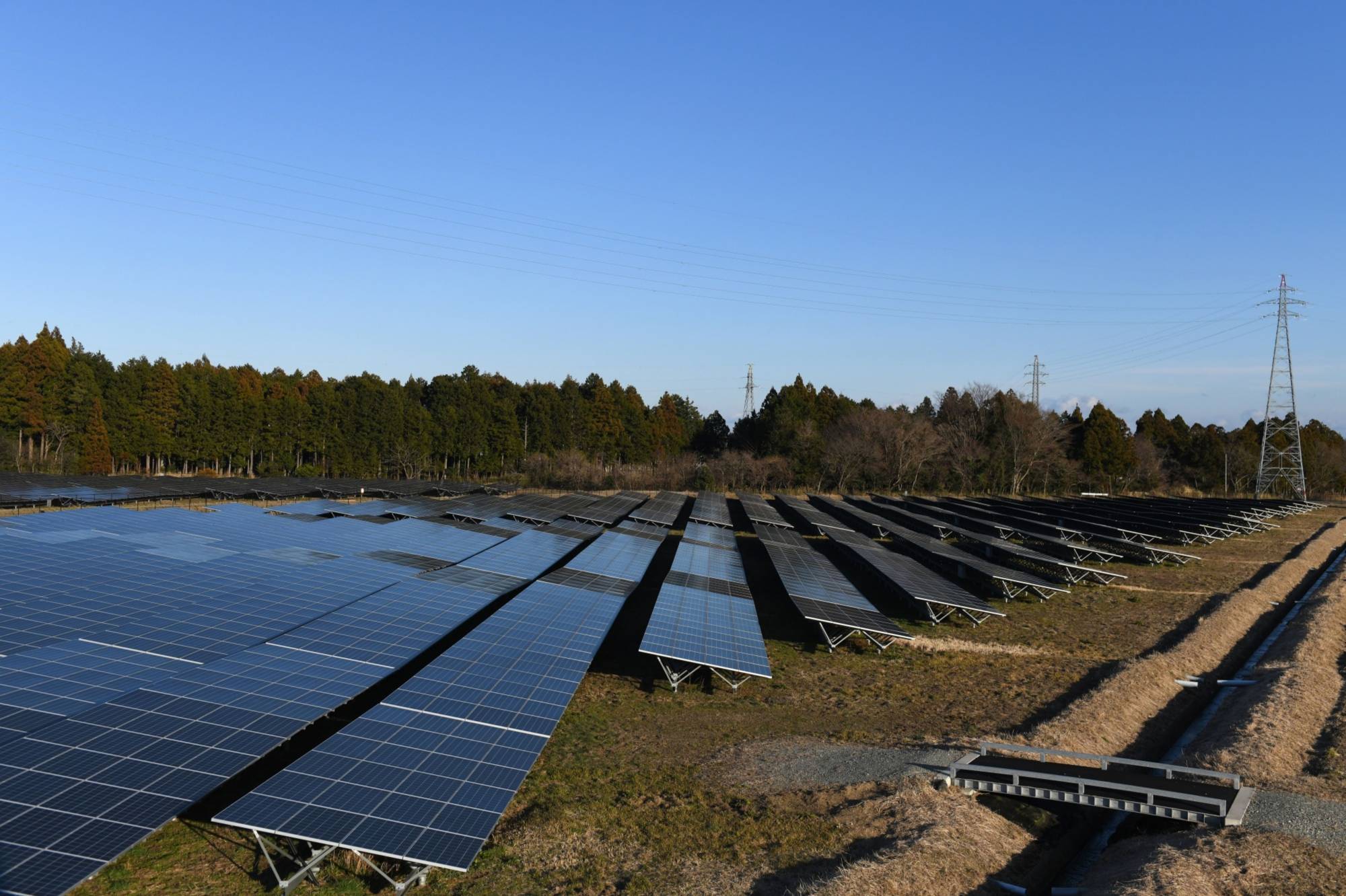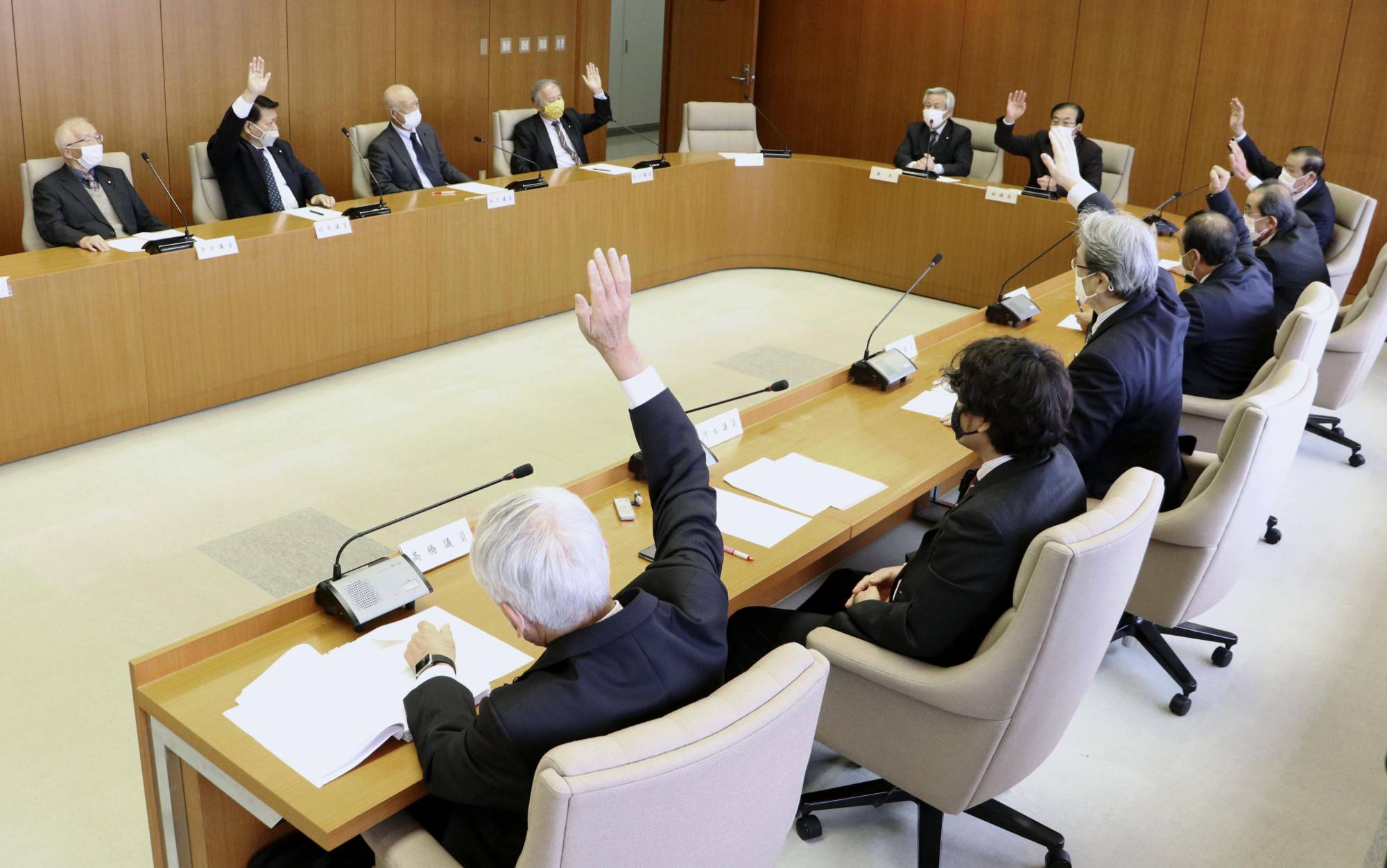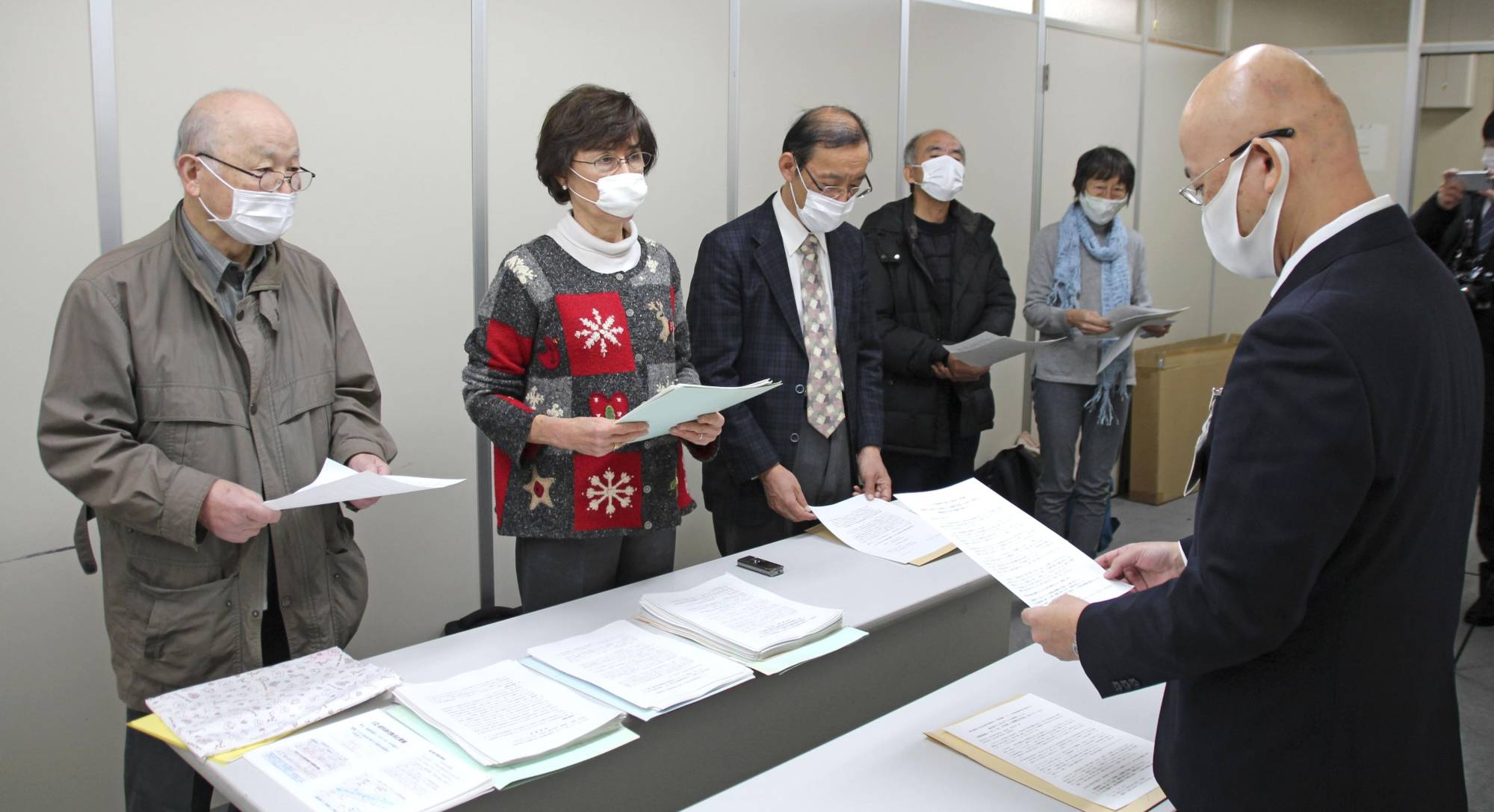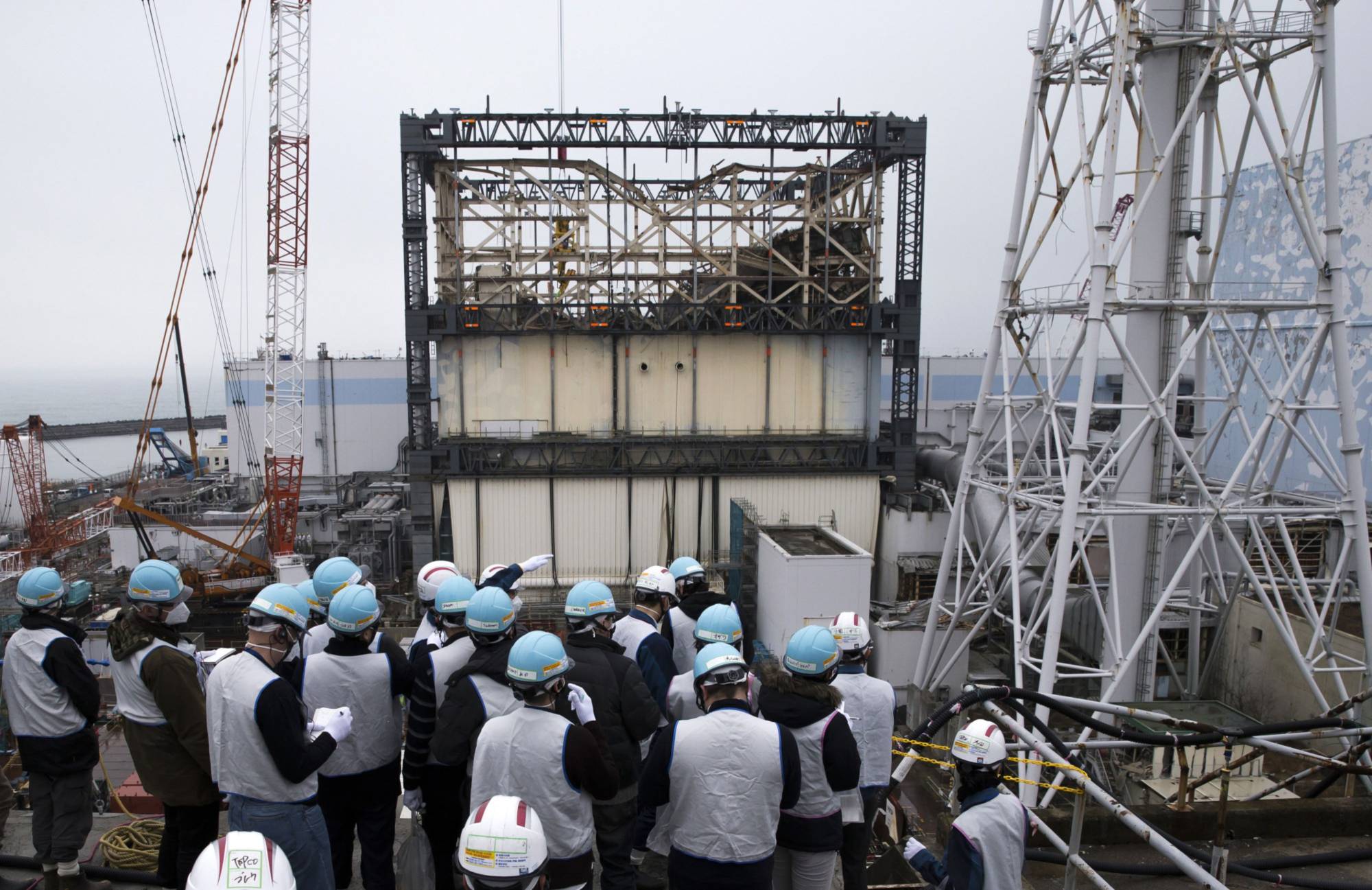That in turn, has touched off a debate over whether more renewable energy or more nuclear power is the best way to provide a safe, stable, secure and green energy supply by the middle of the century.
The current energy plan, adopted by the Cabinet in July 2018, calls for renewable sources to provide between 22% and 24% of Japan’s electricity by 2030, and for nuclear energy to provide between 20% and 22%.
On Dec. 25, the government announced that it was aiming to have renewable energy supply between 50% and 60% of the nation’s electricity by 2050 – nearly a threefold increase over current use. Nuclear power and fossil fuels using carbon capture and storage are expected to account for 30% to 40%, with hydrogen making up much of the remainder. The plan is to keep nuclear power as a main source of energy despite calls to raise the share of renewable energy sources even further.
“We will establish a stable supply of energy by thoroughly conserving energy and introducing renewable energies to the greatest possible extent, as well as by advancing our nuclear energy policy with the highest priority on safety,” Suga said in October when announcing the 2050 carbon neutral target.
“Nuclear power can contribute to supply stability and economic efficiency, which are important for decarbonization of the energy system. The nuclear industry will strive to continuously improve the safety and stable operation of nuclear power generation,” Japan Atomic Industrial Forum president Shiro Arai said in response to Suga’s declaration.
While nuclear advocates say the introduction of new technologies will make plants more efficient and ensure a steady — and cheap — supply of electricity in the decades to come, the industry faces a mountain of problems and questions.
While the government’s official policy is to restart as many nuclear reactors as possible, doing that could prove difficult for four basic reasons: the need for safety upgrades, aging reactors that face decommissioning, the storage of nuclear waste and growing expectations for renewable energy. How these specific issues are addressed in the coming years will impact nuclear power’s share in the electricity mix, and the larger effort to reach carbon neutrality, by 2050.
Safety upgrades
Restart delays due to the need for added safety measures and court cases by nuclear opponents have set back the government’s post-Fukushima plans to bring more reactors online.
In 2010, the year before the Tohoku earthquake, tsunami and resulting triple reactor meltdown at the Fukushima No. 1 nuclear power plant, nuclear power accounted for 25% of Japan’s electricity overall (and up to 50% in the Kansai region). But in 2011, after the disaster, all nuclear reactors went offline and became subject to stricter safety standards under the Nuclear Regulation Authority, which was created in 2012.
Only a few reactors have completed their safety preparations and been restarted. Last year, the Ministry of Economy, Trade and Industry noted that nuclear power generated just 6.2% of the nation’s electricity. By contrast, renewable energy sources including solar, wind, geothermal, hydro and biomass supplied 9.5% of the electricity in 2010 but 18% last year.

As 2020 came to a close, a report by the Agency for Natural Resources and Energy, part of METI, on the status of 60 commercial reactors including those planned or under construction showed that 24 were being decommissioned. Ten of the 24 reactors were located in Fukushima Prefecture. The agency did not include the Monju fast breeder reactor in Fukui or the Fugen prototype reactor, which are also being decommissioned.
Another 11 commercial reactors remain shut down but applications have been submitted for their restarts under the new NRA safety guidelines, while nine others have yet to have their applications submitted. Of the 16 remaining reactors, seven have got the green light for a restart, but operators are finalizing what needs to be done to get them back online.
As of the end of December, the agency was officially listing only nine reactors as having been restarted. Of these, only three, all operated by Kyushu Electric Power Co., were switched on. Three other reactors, including two operated by Kansai Electric Power Co. (Kepco) and one operated by Shikoku Electric Power Co., were shut down for regular inspections. Regular inspections take place about once every year to year and a half, and can take weeks.
The other three reactors (two run by Kepco and one operated by Kyushu Electric) officially said to have been restarted remain offline as their operators race to finish hardening the plants against possible terrorist attacks, as part of the new NRA requirements for reopening. The need for safety upgrades adds to the cost of nuclear power, and keeps the plants offline longer than would otherwise be the case, forcing utilities to make up the supply with other energy sources.
Decommission or extend?
In the United States when nuclear reactors came online in the 1960s and 1970s, it was envisioned they would run for 40 years and then be decommissioned. That became the U.S. government’s policy. However, as plants grew older, there was pressure by the operators to allow a reactor’s life to be extended and some were.
In Japan, after the Fukushima meltdowns, the government, under pressure from the utilities, agreed that operators could have the option of applying for a one-time 20-year extension for a 40-year-old plant, if it met additional safety measures.
Today, of the 33 commercial reactors not being decommissioned (this number excludes Monju, Fugen and three others under construction), four, including three operated by Kepco and one at the Tokai No. 2 plant, are over 40 years old. They have all received restart approval but have yet to go online. Another 11 reactors are now between 30 and 40 years old. Over the next decade, their operators must also decide whether to apply for the two decade extension or decommission them.
Either decision is expensive and time consuming. Operators must calculate whether the cost, in both money and time, to implement new safety and performance upgrades in order to run for another two decades is greater or less than predicted profits from whatever electricity will be provided, and the utilities must take into account that costs are not just for the plant itself.
Getting approval from the local governments that host aging reactors takes time and has traditionally involved various forms of financial compensation to towns, cities and prefectures that host reactors. In addition, after 2011, municipalities within a 30 kilometer radius of a nuclear power plant were asked to draw up evacuation plans in the event of an accident. Local concerns over the viability of such evacuation plans could lead to demands by local officials for the central government to first widen access roads or undertake other expensive civil engineering projects before they grant permission for a restart.
Decommissioning, on the other hand, takes decades and the costs are uncertain. In January of 2020, Kyodo News calculated that the total costs to not only decommission but also implement new safety measures for those plants that continue to operate and maintain them would be at least ¥13.46 trillion. That figure could increase further, eventually leading to higher electricity bills if utilities decide to pass along the added costs to their customers. But whether scrapped or continuing to operate, there is no avoiding an even tougher decision: what to do about the nuclear waste generated.
Waste disposal
Nuclear waste is generally classified as low- or high-level waste. Low-level waste can refer to things like discarded gloves and suits used by plant workers, or parts of the plant exposed to low levels of radiation. High-level waste is usually spent nuclear fuel, which must be vitrified and then stored for up to 100,000 years.

2020 saw the town of Suttsu, Hokkaido, express interest in becoming the destination for the final disposal of Japan’s nuclear waste. If it is actually selected, a process that will take years to decide and decades to complete, a deep underground storage vault would be built and spent fuel from reactors around the country would be transported to Suttsu and nearby Kamoenai for burial.
But there is a more immediate problem. Nuclear power plants have their own facilities to temporarily store spent nuclear fuel, but these are rapidly filling up. There is also a temporary storage facility being built in Mutsu, Aomori Prefecture, by Tokyo Electric Power Company Holdings Inc. and Japan Atomic Power Co. that aims to start up in fiscal 2021 and could be used by other utilities.
Thus, the government hopes to build interim storage facilities, where spent fuel could be stored for about a half century before it’s removed to a final burial site. However, there are no plans, and no interest, on the part of any municipality in Japan so far to allow an interim facility to be built in their neighborhood. If, over the coming years, more reactors are restarted, that means more waste generated, with increasingly fewer places to put it, and no clear plans for either interim or final disposal.
For all of these reasons as well as advances in renewable energy technologies and their increased use, a growing number of business leaders, local governments, renewable energy advocates, politicians and others are calling for the next government energy plan to emphasize nuclear power less and renewable energy more in its 2030 energy strategy and beyond to 2050.
Last month, the Japan Climate Initiative, a consortium of companies, government bodies, NGOs and NPOs (including The Japan Times) committed to raising the share of renewable energy to as much as possible by 2030, called on the government to enact legal reforms that would allow abandoned farmland to be more efficiently used for renewable energy projects, and to review restrictions on such projects in national forests and protected areas.
“Japan has renewable energy sources that are about double the current demand for electricity. Most of it comes from wind power, especially offshore wind power. Development of offshore wind power is underway, but there are challenges such as cost reductions, connecting to the electricity grid, flexibility of service and uncontrolled development,” said Seita Emori, deputy director of the Center for Global Environmental Research at an October symposium sponsored by JCI.

But even with the issues surrounding the future expansion of renewable energy, JCI representative Takejiro Sueyoshi noted at the same symposium that renewable energy use in the first half of 2020 was about 23%, which is already within the range the government had targeted for 2030. He warned that unless more investment was made in renewables, Japan would continue to fall behind the rest of the world.
“In 2019, the renewable energy share of electricity consumption was 71% in Canada, 66% in Denmark, 44% in Germany, 36% in the U.K. and 27% in China. It was only 20% in Japan, although it rose to 23% in the first half of this year,” he said.
So while the Dec. 25 decision to source 50% to 60% of energy needs from renewables is for 2050, there are growing calls on the government to commit to a separate plan that raises the current range of 22% to 24% for renewables to at least 40% by 2030. That idea has the support of 34 prefectures, which made the recommendation in July. In addition, 19 major city governments have voiced support for a target of 45% renewable energy by 2030, while the Japan Association of Corporate Executives is recommending that renewables account for 40% by 2030.
Meanwhile, despite the questions surrounding Japan’s nuclear future and how much power it will really provide in three decades, it still has powerful advocates. After Suga’s declaration that the country would be carbon neutral by 2050, METI Minister Hiroshi Kajiyama and former METI Minister Hiroshige Seko said it was important to consider building new reactors to meet that goal. But Chief Cabinet Secretary Katsunobu Kato ruled that out.
“Some politicians, and some in the industry, are calling for additional nuclear plants. But our calculations show that restarting current reactors is very expensive. If we’re using tax money to invest in new energy technologies, we should be investing in renewables,” said Mika Obayashi, director of the Renewable Energy Institute.

This article is reproduced at www.japantimes.co.jp